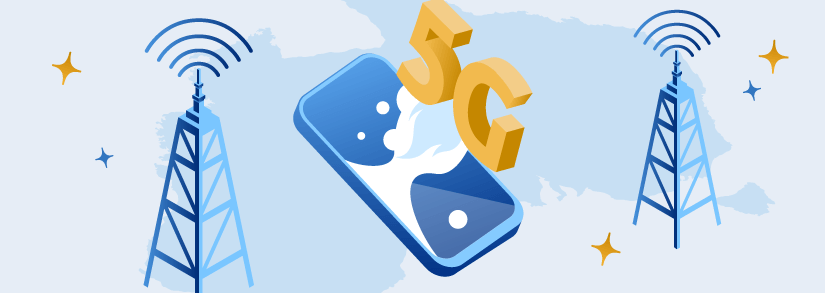5G in Australia: The Rollout of the 5G Network
5G is rolling out across Australia, and the globe. As the newest iteration of the mobile network, 5G is expected to transform the lives of billions of people around the world with its faster-than-ever download speeds and reduced latency. But what is 5G and how different is it from the current 4G network? What can this new technology do? To learn more about the present, and future, of 5G in Australia, continue to read below.
What is 5G?
5G (Fifth Generation) is the latest iteration of wireless communication technology for mobile data networks. Like previous generations, including 2G, 3G, and the current 4G mobile network, 5G is a way for our phones and other mobile devices to communicate and connect, just faster than ever before.
How Does 5G Work?
5G operates in the same way as previous wireless communications systems, but with higher radio frequencies. These higher frequencies, known as ‘millimeter waves’ (mm waves), carry information at a much faster rate than older systems. Because of this, the 5G network will enjoy not only faster download speeds but reduced latency (or faster response times) opening up the 5G network to a whole new world of potential applications.
What Can 5G Be Used For?
5G is more than just faster download speeds on our phones. With low latency, fast download speeds, and reduced slowdowns during peak usage, 5G has the potential to improve many different parts of our lives in ways the average person might not even notice such as the creation and improvement of smart infrastructure in cities, improved production in factories, and more efficient energy systems as we transition to renewable energy sources.
However, 5G has many ways to directly impact and improve our lives, in really cool and interesting ways, such as:
Upgraded mobile service: This is what most people will notice when they connect to the 5G mobile network. Near-instant downloads, HD streaming, improved mobile gaming experience, and broadband-level network connection from anywhere on your phone with the 5G network.
Fixed-wireless broadband: If you don’t want to connect to the National Broadband Network, 5G home wireless broadband is the newest alternative to the NBN. With home wireless broadband you can connect your home to the internet using the mobile network and now with 5G home wireless broadband those speeds are comparable, and indeed oftentimes better, than traditional wired broadband.
Self-driving vehicles: With 5G, self-driving vehicles will be able to connect and gather data at real-time speeds while communicating and cooperating with each other for safer autonomous driving.
VR, and AR: With improved speeds and reduced latency, virtual reality and augmented reality can both expect to see a rise in popularity with the rollout of 5G and as the technology needed for the headsets becomes cheaper.

Looking for a New Internet Plan for Your Home?
Selectra Can Provide Advice & Help You Find The Best Plan

Looking for a New Internet Plan for Your Home?
Selectra Can Provide Advice & Help You Find The Best Plan
5G Networks in Australia
In Australia, all mobile phones are connected to one of three mobile networks, with all other telcos purchasing access to parts of these networks. The three mobile network owners and operators in Australia are:
- Optus
- Telstra
- Vodafone
The 5G network is no different, with each mobile network operator rolling out 5G on their networks in their own time. Currently, if you want to sign up for any plan connected to the 5G network, you will need to do it through either Optus, Vodafone, or Telstra, or either SpinTel or Aussie Broadband on the Optus 5G network.
Telstra 5G Network
Telstra is Australia’s largest network and has been busy at work to make sure the Telstra 5G network is the same. Currently, the Telstra 5G network covers 75% of the Australian population, across 2,700 suburbs and 200 cities and towns, and is the only 5G network available in parts of Tasmania.
Optus 5G Network
The Optus 5G network is currently being rolled out across the country, already covering more than 700,000 homes in almost all major cities and urban areas. Unlike Telstra and Vodafone, Optus not only offers mobile phone plans but was also the first to offer 5G home wireless broadband for residential homes. Optus is also the first network to offer its 5G network to MVNOs and both SpinTel and Aussie Broadband, the only MVNOs to offer 5G network access, do so on the Optus Network.
Vodafone 5G Network
The Vodafone 5G network is the newest, and smallest, 5G network in Australia and has only been switched on since March 2021. While not as expansive as Telstra and Optus, the Vodafone 5G network is rolling out in a targeted approach with the goal of covering 85% of Australia’s six most populous cities - Sydney, Melbourne, Brisbane, Adelaide, Perth, and Canberra.
5G Speeds: How Fast is 5G?
With so much evolution still happening on the 5G network, as it’s rolled out across the country and the technology continues to change and adapt, it’s still unclear just how fast 5G is, on average. What we do know is that 5G is really, really fast and many factors can influence how fast it is for you such as location and which network you’re connected to.
| Mobile Network | Average Download Speeds (January 2026.) |
|---|---|
| 4G (all networks) | 20Mbps-100Mbps |
| Telstra 5G | 509Mbps |
| Optus 5G | 484Mbps |
| Vodafone 5G | 241Mbps |
Source: WhistleOut January 2026. - 5G Speed in Australia
For comparison, old ADSL speeds could reach between 12Mbps and 25Mbps while the National Broadband Network and HFC, which covers most of Australia, only recently rolled out broadband plans with maximum potential speeds above 250Mbps. Most typical NBN plans offer maximum potential speeds between 12Mbps and 100Mbps.
5G Mobile Plans
If you have a 5G-enabled handset or device, you’ll probably want to consider which 5G mobile phone plans are available, and available to you. Before signing up for any 5G mobile plan, it’s always best to check your home address (and possibly work, school, or other places you frequent) to ensure you’re able to get a 5G connection in your area. Below you can find the 5G mobile phone plans available in Australia, by each 5G mobile phone carrier.
Aussie Broadband 5G Mobile Plans
Aussie Broadband has five 5G mobile phone plans on the Optus 5G network. Plans start at $25 per month for 20GB of data, and all plans are no lock-in contract, with unlimited standard national calls and text and international call credits.
| Plan Name | Data Allowance | Price | Detail |
|---|---|---|---|
| Saver | 20GB | $25
Per Month |
|
| Value | 40GB | $35
Per Month |
|
| Essential | 100GB | $50
Per Month |
|
| Premium | 120GB | $60
Per Month |
|
| Elite | 220GB | $70
Per Month |
|
Optus 5G Mobile Plans
Optus has 5G network access available on all of its SIM-only mobile phone plans. Plans start at $52 per month for the Small Optus Choice Plan with 50GB of data, and all Optus 5G mobile plans come with no excess data charges and national talk and text.
| Plan Name | Data Allowance | Price | Detail |
|---|---|---|---|
| 7 Day Pre-Paid | 5GB | $13
Per 7 Day Renewal |
|
| 20 GB Pre-Paid | 20GB | $35
Per 28 Day Renewal |
|
| 25 GB Pre-Paid | 25GB | $39
Per 28 Day Renewal |
|
| 35 GB Pre-Paid | 35GB | $49
Per 28 Day Renewal |
|
| 45 GB Pre-Paid 6 Month | 45GB | $59
Per 186 Day Renewal |
|
| 90 GB Pre-Paid 6 months | 90GB | $180
Per 1 Year Renewal |
|
SpinTel 5G Mobile Plans
SpinTel has four 5G mobile phone plans available on the Optus 5G network. Choose between either a modest 25 GB of data per month, or a whopping 200GB of data per month, and get unlimited standard national talk and text, plus no lock-in contract.
| Plan Name | Data Allowance | Price | Detail |
|---|---|---|---|
| 25 GB Plan | 25GB | $22
Per Month |
|
| 50 GB Plan | 50GB | $29
Per Month |
|
| 100 GB Plan | 100GB | $35
Per Month |
|
| 200 GB Plan | 200GB | $50
Per Month |
|
Telstra 5G Mobile Plans
Telstra’s three 5G phone plans all come on a no lock-in contract and have unlimited standard national talk & text, international minutes, unlimited international texting, data sharing, and endless data at 1.5Mbps with no excess data usage charges.
| Plan Name | Data Allowance | Price | Detail |
|---|---|---|---|
| 7 Day Pre-Paid | 3GB | $13
Per 7 Day Renewal |
|
| 15 GB Pre-Paid | 15GB | $39
Per 28 Day Renewal |
|
| 25 GB Pre-Paid | 25GB | $49
Per 28 Day Renewal |
|
| 35 GB Pre-Paid | 35GB | $59
Per 28 Day Renewal |
|
| 70 GB Pre-Paid | 70GB | $69
Per 28 Day Renewal |
|
| 70 GB Pre-Paid 6 Month | 70GB | $180
Per 6 Month Renewal |
|
| 165 GB Pre-Paid 1 Year | 165GB | $350
Per 1 Year Renewal |
|
Vodafone 5G Mobile Plans
All Vodafone SIM-only plans have access to the Vodafone 5G network. Plans start at $40 / month, and all plans include unlimited standard national talk and text, as well as infinite data at reduced speeds, and some international inclusions.
| Plan Name | Data Allowance | Price | Detail |
|---|---|---|---|
| 7 Day Pre-Paid
See detail |
5GB | $12
Per 7 Day Renewal |
|
| 25 GB Pre-Paid
See detail |
25GB | $35
Per 28 Day Renewal |
|
| 35 GB Pre-Paid
See detail |
35GB | $45
Per 28 Day Renewal |
|
| 50 GB Pre-Paid
See detail |
50GB | $55
Per 28 Day Renewal |
|
| 90 GB Pre-Paid 6 Month
See detail |
90GB | $160
Per 185 Day Renewal |
|
| 150 GB Pre-Paid 1 Year
See detail |
150GB | $250
Per 1 Year Renewal |
|
5G and Landlines Currently, most 5G home broadband plans don't support home phone services. If you want to keep a landline, it's best to consider an NBN plan instead.

Looking for a New Internet Plan for Your Home?
Selectra Can Provide Advice & Help You Find The Best Plan

Looking for a New Internet Plan for Your Home?
Selectra Can Provide Advice & Help You Find The Best Plan
The 5G Network in Australia: FAQs
When is 5G Coming to Australia?
5G has been in Australia since its global rollout in 2019 and has continued to expand across the country in the years following. As of January 2026., the Telstra 5G network reports having reached 75% of Australian homes and the Vodafone 5G network hopes to cover 85% of the most populous Australian cities.
Is 5G Safe?
Like with any new technology, the 5G mobile network is not without controversy and misinformation. However, there is no scientific evidence that 5G is harmful. According to the Australian Government Department of Health on 24 January 2020,
There is no evidence telecommunication technologies, such as 5G, cause adverse health impacts. This position is supported by health authorities in Australia – such as the Australian Radiation Protection and Nuclear Safety Agency (ARPANSA) – and around the world, such as the World Health Organization (WHO).
Mobile phone networks and other wireless telecommunications (such as smart meters for your energy usage) emit low-powered radio waves also known as radiofrequency (RF) electromagnetic energy (EME). RF EME has been the subject of controversy over the years, with people claiming health issues as a result of exposure. Despite these claims, there is no scientific evidence to support the idea that the 5G network or RF EME poses any sort of health risk to people.
How Do I Get 5G?
If you want to connect to the 5G network, there are a few steps you need to take.
- Wait for 5G to be available in your area. Check a 5G coverage map to see if it’s been rolled out to your home (and double-check your work or school as well)
- Get a 5G-enabled handset since your old mobile phone probably can’t connect to the 5G network itself. The good news is that you don’t need the latest, most expensive phone to get 5G, and plenty of budget 5G-enabled phones are available.
- Sign up for a 5G mobile plan.
Click below to find a better deal for your home!




